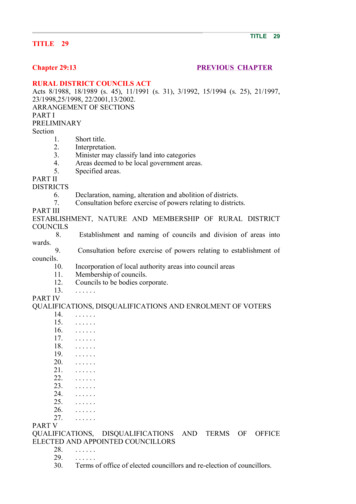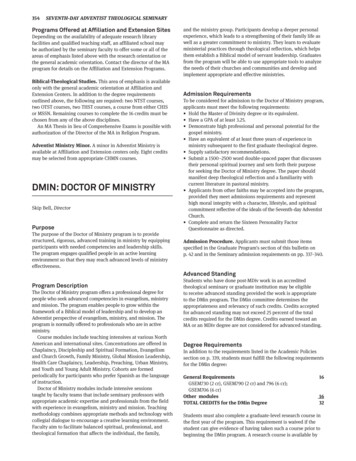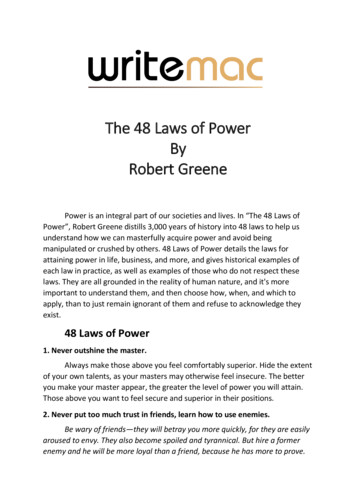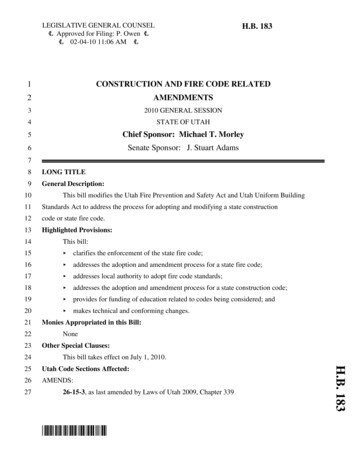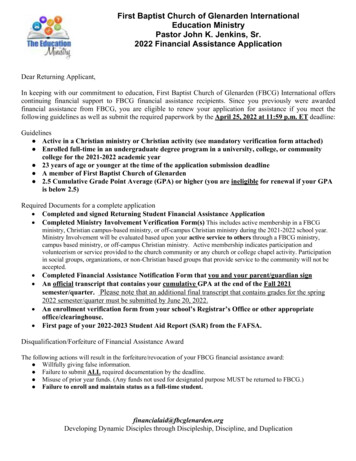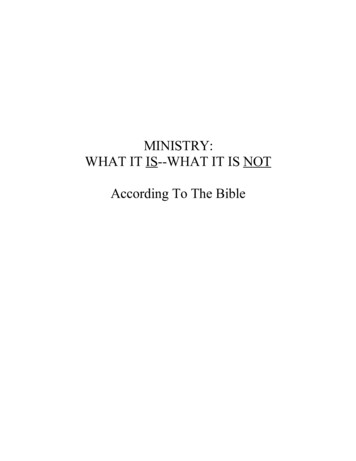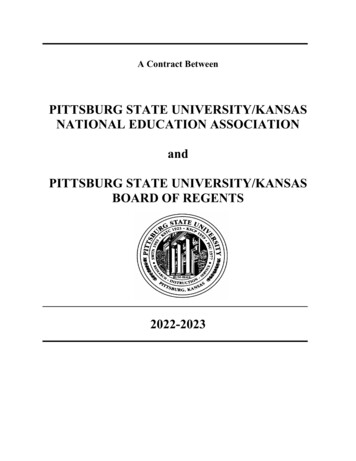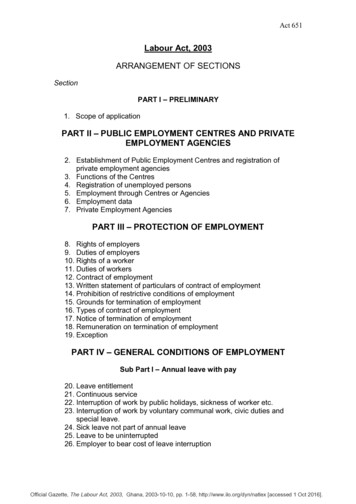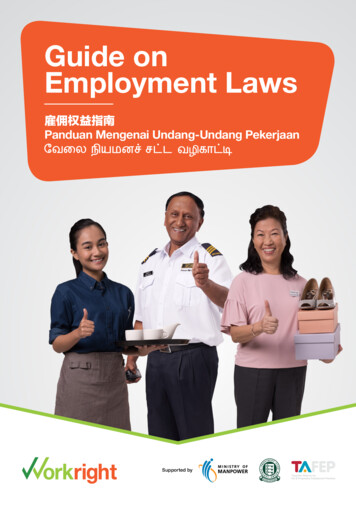
Transcription
Guide onEmployment Laws雇佣权益指南Panduan Mengenai Undang-Undang PekerjaanSupported by1
The Employment Act spells out the rights andresponsibilities of employees and employersunder a contract of service.If you are a Singapore Citizen or SingaporePermanent Resident, you are entitled to CentralProvident Fund (CPF) contributions.Am I Coveredunder theEmployment Act?The Employment Act covers everyemployee (regardless of nationality)who is under a contract of servicewith an employer, except: Seafarers Domestic workers Statutory board and governmentemployeesDid You Know?Part IV of the Employment Act, which covers working hours, rest days, and otherconditions of service, is applicable to workmen whose basic monthly salaries donot exceed 4,500 and non-workmen whose basic monthly salaries do not exceed 2,600. Part IV is not applicable to managers and executives.2
Differences between Contract ofService and Contract for ServiceA contract of service is an agreement between an employer and an employee.A contract for service is an agreement between a client and an independentcontractor, such as a self-employed person or vendor, who is engaged to carryout an assignment or project for an agreed fee. The Employment Act does notapply to such persons.To determine whether you are on a contract of service or a contract for service, youwould need to consider a number of factors holistically. Some key factors include: Who is responsible for the provision of work? Who provides the tools and equipment? Is the business carried out on the person's own account or is it for the employer?To find out more about the factors to be considered,please refer to the MOM website: www.mom.gov.sg Employment practices Contract of serviceIf you are employed on a contract of service,you must be issued with the Key EmploymentTerms (KETs) and Itemised Pay Slips.To minimise disputes on theagreed terms and conditions,the contract should be in writing,e.g. a letter of appointment,and include details of the KETs.3
1Key EmploymentTerms (KETs)Your employer is required to issue Key EmploymentTerms (KETs) in writing to you.KeyEmploymentTermsWhoshould receivewritten KETs? All employees whoare hired on/after1 April 2016 andemployed for acontinuous periodof 14 days or more4Whenshould writtenKETs be issued? Within 14 daysafter the first dayof employmentWhatform can thewritten KETs take? Can be issued insoft or hard copy Common keyemployment termscan be providedin an employeehandbook and/orcompany intranet
Your employer should include the following items (listed in the table below) in your KETs.CategoryItem descriptionDetails ofemployment1. Full name of employer2. Full name of employee (as specified on the identitycard, work pass or passport)3. Job title, main duties and responsibilities4. Start date of employment5. Duration of employment (if you are employed on afixed-term contract)Working hoursand rest day6. Working arrangements: Daily working hours (e.g. 9.00am to 6.00pm,including 1 hour lunch break) Number of working days per week (e.g. 5) Rest day (e.g. Sunday)Salary7. Salary period (e.g. 1 Jan 2019 to 31 Jan 2019)8. Basic salaryFor hourly, daily or piece-rated employees,employers should indicate the basic rate of pay(e.g. X per hour, day or piece)9. Fixed allowances10. Fixed deductions11. Overtime payment period (if different from salary period)12. Overtime rate of pay13. Other salary-related components, such as: Bonuses IncentivesLeave andmedical benefits14. Types of leave, such as: Annual leave Outpatient sick leave Hospitalisation leave Maternity leave Paternity leave Childcare leave15. Other medical benefits, such as: Insurance Medical/Dental benefitsOthers16. Probation period17. Notice period18. (Optional) Place of work Indicate if the work location is different from theemployer’s address. Although optional, employersare strongly encouraged to include this5
2WorkingHoursYour contractual working hours (excluding breaktime and overtime) cannot exceed 8 hours a dayor 44 hours a week.WorkingHoursLunchBreakHoursWorkedfor the Day(assuming 5.5 day week)9.00am to6.00pm1 hour8 hours8 x 5.5 44 hoursIf you work more than 8 hours ina day or 44 hours in a week, theextra hours of work are consideredovertime. Overtime payment is at1.5 times the hourly basic rate of payif your employer requiresyou to work overtime.6Hours Workedfor the Week
Computation and Paymentfor Overtime WorkIf you are monthly-rated, yourhourly basic rate of pay can becalculated as such:Total basic payin a yearTotal numberof working hoursin a year 12 months in a year xmonthly basic rate of pay52 weeks in a year x44 hours in a weekFor example, if you earn 1,200 basic salary per month,your hourly basic rate of pay is:12 x 1,20052 x 44 6.30 (to the nearest cent)For each hour of overtime that you work, your overtime pay is calculated as: 6.30 x 1.5 (overtime rate) 9.50 (to the nearest cent)Including overtime, you should not work more than 12 hours a day (excluding breaktimes). Your total overtime must not exceed 72 hours in a month.To calculate your overtime pay, please refer to the MOM website:www.mom.gov.sg Employment practices Salary Calculate overtime payDid You Know?Regulations on working hours and overtime payment under the Employment Actare only applicable to workmen whose basic monthly salaries do not exceed 4,500and non-workmen whose basic monthly salaries do not exceed 2,600. They arenot applicable to managers and executives.If you are a shift worker, please refer to the MOM website:www.mom.gov.sg Employment practices Hours of work, overtime and rest day7
3Paymentof SalaryYour salary and overtime pay must be paid at leastonce a month and not later than the following timeline:PaymentDeadlineExampleSalaryWithin 7 days after theend of the salary periodSalary must be paid by7 Feb 2019OvertimePayWithin 14 days after theend of the salary periodOvertime pay must be paidby 14 Feb 20194(Salary Period: 1 Jan 2019 to 31 Jan 2019)ItemisedPay SlipsYour employer is required to issue itemised pay slipsto you.WhenFormat8 To be issued when salary is paid or within 3 workingdays after salary is paid In the case of termination or dismissal, pay slip mustbe issued together with outstanding salary Soft or hard copy
Items to includeYour employer should include the following items (listed in the table below) in your itemisedpay slips. If payments are made more than once a month, employers can consolidate pay slips.The consolidated pay slip must contain details of all payments made since the last pay slip.CategoryItem detailsSalary details1. Full name of employer2. Full name of employee (as specified on the identitycard, work pass or passport)3. Date of payment (or dates, if the pay slipsconsolidate multiple payments) Salary Overtime4. Basic salaryFor hourly, daily or piece-rated workers, indicateall of the following: Basic rate of pay (e.g. X per hour, day or piece) Total number of hours or days workedor pieces produced5. Start and end dates of salary period(e.g. 1 Jan 2019 to 31 Jan 2019)Allowances,deductions andothers6. Allowances paid in each salary period, such as: All fixed allowances (e.g. transport) All ad-hoc allowances(e.g. one-off uniform allowance)7. Any other additional payment in each salary period,such as: Bonuses Rest day pay Public holiday pay8. Deductions made in each salary period, such as: All fixed deductions (e.g. employee’sCPF contribution) All ad-hoc deductions (e.g. deductionsfor no-pay leave, absence from work)Overtime details9. Overtime hours worked10. Overtime pay11. Start and end dates of overtime payment period(if different from salary period)Net salary12. Net salary paid in total9
5CPFContributionsIf you are a Singapore Citizen or SingaporePermanent Resident employee earning total wagesof more than 50 per month, your employer mustcontribute CPF for you. This is applicable even ifyou are working on a part-time/ ad-hoc/ contractbasis or during your probation.Employers are required to pay both theemployer and employee’s share of CPFcontributions every month.Your employer is entitled to recoveryour share of the contribution from yourtotal wages if you earn more than 500per month.10
CPF contributions are exempted for the followingclasses of employees:1.Certain classes of student employees. Find out more about who youneed to pay CPF contributions for under the header “Students” ouNeedToPayCPFFor.pdf2.Foreigners on Employment Pass, S Pass, Miscellaneous Work Pass or Work Permit.3.Domestic employees whose domestic employment does not exceed 14 hoursin any week.4.Employees of the United Nations Organisation, or any agency or institution ofthe United Nations Organisation stationed in Singapore.5.Seamen who are Singapore Citizens and are employed –a. in a Swedish ship on terms and conditions of service applicable toSwedish seamen;b. in a Norwegian ship on terms and conditions of service applicable toNorwegian seamen; orc. by the East Asiatic Co. Ltd. of Denmark on terms and conditions ofthe agreement between the Danish Shipowners’ Association and theSeamen’s Union in Denmark.6.Employees who are employed by the General Conference Corporation ofSeventh Day Adventists under a contract of service or other agreemententered into outside Singapore and who is not domiciled in Singapore.CPF contributions are not payable for the followingclasses of employees:1.2.3.Employees working overseas.Seamen who are Singapore Permanent Residents.Seamen who are Singapore Citizens whose contract of service or other agreement isentered into outside of Singapore.How are my CPF contribution rates determined?Your CPF contributions rates are determined by three factors: Your wage band Your age group Your citizenship i.e. Singapore Citizen or Singapore Permanent Resident (SPR)Did You Know?First and second year Singapore Permanent Residents will contribute CPF atgraduated rates.11
Computation of CPF ContributionsYour CPF contributions are computed based on the total wages that you earn eachmonth. The tables below show the different types of payments that CPF contributionsare payable and not payable for:CPF PayableBasic wagesOvertime payCash incentives(e.g. Good Service Awards)Allowances(e.g. for meal, laundry, transport)Commissions(e.g. sales commissions)BonusesCPF Non-PayableGenuine Reimbursement of BusinessExpenses* (e.g. transport claims forbusiness meetings, laundry expenses foruniforms, accommodation for overseasbusiness meetings)*Reimbursed amount must not exceed actual expenditure.Termination benefits(e.g. retirement gratuity, retrenchment pay,compensation for insufficient notice)Gifts in kind(e.g. shopping vouchers)You can find more information on the different types of payments that CPF contributionsare payable at cpf.gov.sg/allowancesandpaymentsTo calculate how much CPF contributions your employers need to contribute for you,use the CPF Contribution Calculator at cpf.gov.sgDid You Know?12 If you earn more than 50 and not more than 500 in a month, you are notrequired to make CPF contributions on your part. Your CPF contributions will bepaid solely by your employer. Your employer should contribute your monthly CPF by the 14th of the following month. With CPF contributions, you can receive Workfare Income Supplement (WIS)if you are eligible. Visit www.workfare.sg for more details. CPF contributions are computed in whole numbers.
6RestDayYou should have one rest day everyweek without pay. If you work onyour rest day, you should be paidbased on the following terms:For up tohalf yournormal dailyworkinghoursFor morethan halfyour normaldaily workinghoursBeyond yournormal dailyworkinghoursAt youremployer’srequest1 day’s salary2 days’ salary2 days’ salary overtime payAt yourownrequestHalf day’s salary1 day’s salary1 day’s salary overtime payIf youworkDid You Know?Regulations on rest days under the Employment Act are only applicable toworkmen whose basic monthly salaries do not exceed 4,500 and non-workmenwhose basic monthly salaries do not exceed 2,600. They are not applicable tomanagers and executives.13
7Public Holidays,Sick Leave andAnnual LeavePublic HolidaysYou are entitled to 11 paid public holidays per year.If you are required to work on a public holiday, youremployer should pay you an extra day’s salary orgrant you a day off in lieu.If you are not covered under Part IV of the Employment Act, your employercan also grant you time off in lieu for working on a public holiday. The timeoff should consist of a mutually agreed number of hours. If there is no mutualagreement on the duration of time off in lieu, your employer can decide onone of the following:Pay an extra day’ssalaryFor 4 hours or lessof work on a publicholiday, grant timeoff in lieu of 4 hourson a working dayFor more than4 hours of work ona public holiday,grant a full day offon a working dayFor more information on your employment entitlement to public holidays, please referto the MOM website:www.mom.gov.sg Employment practices Public holidays: entitlement and payDid You Know?The 11 paid public holidays are New Year’s Day, Chinese New Year (two days), GoodFriday, Labour Day, Vesak Day, National Day, Hari Raya Puasa, Hari Raya Haji, Deepavaliand Christmas Day. Please refer to the MOM website for other gazetted public holidays:www.mom.gov.sg Employment practices Public holidays14
Sick LeaveYou are entitled to paid sick leave and paidhospitalisation leave if: You have worked for at least 3 months with your employer; and You have informed or tried to inform your employer within48 hours of your absence.To qualify for paid sick leave, you must be: Certified unfit for work by a medical practitioner registered under theMedical Registration Act or Dental Registration ActTo qualify for paid hospitalisation leave, you must be: Warded in a hospital as an in-patient or for day surgeryQuarantined under any written lawCertified by a medical practitioner who can admit patients into an approvedhospital, including medical practitioners from national specialty centresand ambulatory surgical centresThe number of days of paid sick leave and paid hospitalisation leave that youare entitled to depends on your service period:Number of months ofservice completedPaid sickleave (days)Paid hospitalisationleave (days)3 months5154 months8305 months11456 monthsand thereafter1460Did You Know?The list of national specialty centres and ambulatory surgical centres is availableon the MOM website: www.mom.gov.sg Employment practices Leave Sick leave Eligibility and entitlement15
Annual LeaveIf you have worked with your employer for at least3 months, you are entitled to paid annual leave.Your annual leave entitlement should not be lessthan the following:Years ofContinuous ServiceDays ofAnnual Leave172839410511612713814and thereafterIf you worked at least 3 months but less than a year, your annual leavewould be pro-rated based on the number of full months you have worked.This applies even if you are on probation.For example, if you have worked for 6 months, your pro-rated leave is:6 full monthsof service12 monthsin a year16x7 days(first year entitlement) 4 days(to the nearest day)
What if I am a part-time employee?You are considered a part-time employee if you workless than 35 hours a week under a contract of service.You are also entitled to employment benefits such as paid public holidays,sick leave, annual leave and childcare leave. However, your employmentbenefits would be pro-rated according to the number of hours worked bya similar full-time employee.No. of working hoursper year of apart-time employeeNo. of working hoursper year of a similarfull-time employeeXRelevant employmentbenefits that afull-time employeeis entitledXNo. of working hoursin a day of a similarfull-time employeeFor example, if you are a part-time employee who works 22 hours per week,your public holiday entitlement is:22 hours of x 52 weekswork in a weekin a year44 hours of x 52 weekswork in a weekin a year118X Public X HoursHolidays 44 hoursof pay for11 publicholidaysTherefore, for every public holiday, you should be paid:44 hours11 days 4 hours17
For more details on your employment rights, visitwww.mom.gov.sg/workrightNeed Help?Call the Workright hotline at1800-221-9922or emailworkright@mom.gov.sgAll information will be kept strictly confidential.18
19
card, work pass or passport) 3. Job title, main duties and responsibilities 4. Start date of employment 5. Duration of employment (if you are employed on a fixed-term contract) Working hours and rest day 6. Working arrangements: Daily working hours (e.g. 9.00am to 6.00pm, including 1 hour lunch break) Number of working days per week (e .

